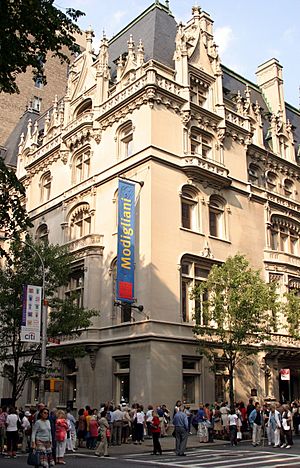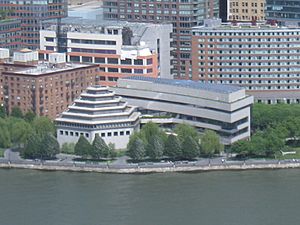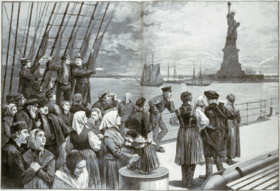Jews in New York City facts for kids
Quick facts for kids Jews in New York Cityייִדן אין ניו יאָרק יהודים בניו יורק |
|
|---|---|

Jewish shopkeeper in New York City, circa 1929
|
New York City is home to the largest Jewish community outside of Israel. About 13% of the city's population is Jewish. In 2014, around 1.1 million Jewish people lived in the five boroughs of New York City. Across all of New York State, there were 2 million Jewish residents.
Jewish people have been coming to New York City since 1654. This was when the first Jewish settlers arrived in New Amsterdam, which is what New York was called back then. A very large number of Jewish immigrants came to the city between the late 1800s and early 1900s. During this time, the Jewish population grew from about 80,000 in 1880 to 1.5 million in 1920.
The large Jewish population has had a big impact on the culture of New York City. After a decrease in numbers during the 20th century, the Jewish population in New York City has grown a lot in the 21st century. This growth is mainly because of the high birth rate in the Hasidic and Orthodox communities.
Contents
Jewish Population in New York City
In 2016, about 1.1 million people living in New York City were Jewish. This means about 12% of the city's residents were Jewish.
Here is how the Jewish population in New York City has changed over time:
| Year | Jewish population of New York City |
|---|---|
| 1654 | 23 |
| 1750 | 300 |
| 1850 | 16,000 |
| 1859 | 40,000 |
| 1880 | 80,000 |
| 1920 | 1,600,000 |
| 1950 | 2,000,000 |
| 1981 | 1,100,000 |
| 1991 | 1,027,000 |
| 2002 | 972,000 |
| 2012 | 1,100,000 |
The New York metropolitan area has about 1.5 million Jewish people. This makes it the second-largest Jewish community in the world, after the Tel Aviv Metropolitan Area in Israel. However, New York City itself has more Jewish residents than Tel Aviv. New York City's Jewish population is larger than the combined Jewish populations of Chicago, Philadelphia, San Francisco, and Washington, D.C..
The number of Jewish people in New York City grew quickly in the early 1900s. It reached its highest point in the 1950s, with 2 million Jewish residents. At that time, one-quarter of the city's population was Jewish. After the 1950s, the Jewish population started to decline. This was due to lower birth rates and people moving to suburbs or other states like California and Florida.
By the 1920s, New York City was home to about 45% of all Jewish people in America. In the 1980s and 1990s, new groups of Jewish immigrants arrived. These included Ashkenazi Jews and Bukharian Jewish people from the former Soviet Union. Sephardic Jews, including Syrian Jews, have also lived in New York City since the late 1800s. Many Russian, Lithuanian, and Polish Jews also came in large numbers during the mid-1800s.
There are also many Mountain Jews from Azerbaijan and the South Caucasus living in Brooklyn. Bukharian Jews from Uzbekistan and Central Asia have settled in Forest Hills, Queens. Many Jewish people, including newer immigrants, have moved to Queens, south Brooklyn, and the Bronx. Most now live in middle-class neighborhoods.
Brooklyn has a very high number of Jewish residents. About 561,000 people there are Jewish, which is one out of every four residents. Borough Park is known for its large Orthodox Jewish population. In 2015, it had the city's highest birth rate. However, the fastest-growing communities of American Orthodox Jews are in Rockland County and the Hudson Valley. These include places like Monsey, Monroe, New Square, Kiryas Joel, and Ramapo.
Within the larger New York metropolitan area, many Orthodox Jewish communities are growing fast in New Jersey. This is especially true in Lakewood and nearby Ocean County. Beth Medrash Govoha, the world's largest yeshiva (a Jewish school) outside Israel, is located there.
In 2002, about 972,000 Ashkenazi Jews lived in New York City. They made up about 12% of the city's population. New York City is also home to the world headquarters of several important Jewish groups. These include the Chabad, Bobover, and Satmar branches of Hasidism. Other Haredi (ultra-Orthodox) Jewish groups also have their centers here.
While most Jewish people in New York do not consider themselves very religious, the Orthodox community is growing quickly. This is due to the high birth rates among Hasidic Jews. The numbers of Conservative and Reform Jews are decreasing.
Many Jewish organizations have their main offices in New York. These include The Agudath Israel of America, The Orthodox Union, Chabad, and The Rohr Jewish Learning Institute.
Most Jewish people in New York City are white. However, some Jewish New Yorkers identify as Asian, Black, Latino, or multiracial. A 2011 study found that 12% of Jewish households in the city were non-white or biracial.
Many Jewish immigrants from Arab countries have settled in New York City. They have formed a Sephardic community, mostly in Brooklyn. This community is mainly made up of Syrian Jews. Other Arab Jewish people in New York City come from Egypt, Israel, Lebanon, and Morocco.
Arab Jewish immigrants first started arriving in New York City in large numbers between 1880 and 1924. When Syrian Jews first came, some Eastern European Ashkenazi Jews on the Lower East Side sometimes called them Arabische Yidden, meaning "Arab Jews." Some Ashkenazim even wondered if Sephardic/Mizrahi Jews from the Middle East were truly Jewish. In response, some Syrian Jews, proud of their ancient heritage, called Ashkenazi Jews "J-Dubs."
In 1990, there were 11,610 Arab Jewish people in New York City. This was 23% of the city's total Arab population. Egyptian Jews arrived in New York City more recently than Syrian Jews. Many Egyptian Jews speak Ladino, Arabic, and French. Most Egyptian-Jewish immigrants to the city are Sephardi/Mizrahi. Very few are Ashkenazi. Ladino-speaking Egyptian Jews often settled in the Forest Hills neighborhood of Queens.
Many Central Asian Jews, mostly Bukharian Jews from Uzbekistan, have settled in Queens. They live in neighborhoods like Rego Park, Forest Hills, Kew Gardens, and Briarwood. In 2001, about 50,000 Bukharian Jews lived in Queens. Queens also has a large Georgian-American community of about 5,000 people. Around 3,000 of them are Georgian Jews. Queens has the third-largest population of Georgian Jews in the world, after Israel and Georgia. Forest Hills is home to the Congregation of Georgian Jews, which is the only Georgian-Jewish synagogue in the United States.
History of Jewish People in New York
Early Jewish Settlers (1654–1881)

The first Jewish settler recorded in New York was Jacob Barsimson. He arrived in August 1654. A month later, a group of Jewish people came to New York, then called New Amsterdam. They were refugees from Recife, Brazil. Portugal had taken back Dutch Brazil from the Netherlands, and the Sephardi Jews there quickly fled. Most went to Amsterdam, but 23 of them came to New Amsterdam.
The governor, Peter Stuyvesant, did not want to accept them at first. But he gave in to pressure from the Dutch West India Company, which had Jewish investors. He allowed them to stay but put many rules and taxes on them. Eventually, many of these Jewish settlers left.
When the British took the colony from the Dutch in 1664, only one Jewish name was on the loyalty oath: Asser Levy. This is the only record of Jewish presence until 1680, when some of Levy's relatives arrived from Amsterdam.
The first synagogue, the Sephardic Congregation Shearith Israel, was started in 1682. It got its own building in 1730. This synagogue became very important in Jewish life. It organized social services and required all New York Jews to be part of it. Even though by 1720, Ashkenazi Jews outnumbered Sephardic Jews, the Sephardic customs were kept.
After the Napoleonic Wars in Europe, many German and Polish Jews came to New York. The growing number of Ashkenazi Jews led to the founding of the city's second synagogue, B'nai Jeshurun, in 1825. More synagogues followed quickly, including the first Polish one, Congregation Shaare Zedek, in 1839. In 1845, the first Reform temple, Congregation Emanu-El of New York, opened. By the 1920s, New York City had several schools where rabbis could be trained.
Many community aid groups were formed during this time. Two important ones joined together in 1859 to create the Hebrew Benevolent and Orphan Asylum Society. Jewish orphanages were built in Manhattan and Brooklyn. In 1852, the "Jews' Hospital" was started. It was later renamed Mount Sinai Hospital in 1871 and became one of the best hospitals in the country.
Jewish day schools also began to appear in the 1800s. The first one was the Polonies Talmud Torah in 1821.
Mass Immigration (1881–1945)
The years between 1881 and 1917 saw the largest wave of immigration to the United States. After the assassination of Alexander II of Russia, many blamed "the Jews." This led to a huge increase in anti-Jewish attacks called pogroms, possibly with government support. Many anti-Jewish laws were also passed. As a result, over 2 million Jewish people immigrated to the United States. More than a million of them came to New York City.
During this time, Eastern Ashkenazi Jews and their culture thrived. Many came from countries like Lithuania, Poland, and Russia. Their synagogues and businesses, especially shops selling goods from their home countries, helped them keep their identity, language, and customs.
New York was the publishing city for the Yiddish newspaper, Forverts, which started in 1897. Several other Jewish newspapers were also published in common Jewish languages like Ladino, Yiddish, and Hebrew.
These immigrants were often young and not very religious. They were usually skilled, especially in the clothing industry. This industry soon became very important to New York's economy. By the end of the 1800s, Jewish people also "dominated related fields such as the fur trade."
The German Jews, who were often wealthy by this time, did not always welcome the Eastern Ashkenazi arrivals. They moved to uptown Manhattan, away from the Lower East Side where most immigrants settled. Still, many of these Eastern European immigrants worked in factories owned by the "uptown" German Jews.
New York City Parks with Jewish Cultural Connections
The New York City Department of Parks and Recreation has many parks. Some are named after Jewish people, and others have monuments related to Jewish culture and history.
Manhattan Parks
- Abe Lebewohl Park
- Asser Levy Recreation Center
- Baruch Playground
- Bella Abzug Park
- Gustave Hartman Triangle
- Jacob H. Schiff Playground
- Schiff Malls
- Jacob Joseph Playground
- Jacob K Javits Playground
- Montefiore Park
- Nathan Straus Playground
- Straus Park
- Straus Square
- Peretz Square
- Sidney Hillman Playground
- Sol Bloom Playground
- Sol Lain Playground
- Sophie Irene Loeb Playground
- Stanley Isaacs Playground
- Vladeck Park
- American Memorial to Six Million Jews of Europe (Riverside Park)
- Charles and Murray Gordon memorial (Fort Washington Park)
- Emma Lazarus Memorial Plaque (Battery Park)
- Jerusalem Grove (Battery Park)
- The Immigrants Sculpture (Battery Park)
- Gertrude Stein monument (Bryant Park)
- Jewish Tercentenary Monument (Peter Minuit Plaza)
- Loeb Memorial Fountain (Central Park)
- Schiff Fountain (Seward Park)
Bronx Parks
- Ben Abrams Playground
- Hank Greenberg Ballfield
- Heinrich Heine Fountain (Joyce Kilmer Park)
- Keltch Park
- Netanyahu Memorial (Pelham Parkway)
Brooklyn Parks
- Alben Triangle
- Asser Levy Park
- Babi Yar Triangle
- Colonel David Marcus Playground
- Harold W. Cohn Memorial Square
- Kolbert Playground
- Harry Maze Playground
- Holocaust Memorial Park
- Jacob Joffe Field
- Kaiser Park
- Lew Fidler Park
- Rapaport Playground
- Sobel Green
- Zion Triangle
Queens Parks
- Cardozo Playground
- Federoff Triangle
- Gwirtzman Triangle
- Haym Salomon Square
- Ilse Metzger Sitting Area (Flushing Meadows-Corona Park)
- Sobelsohn Playground
- Rabbi Kirshblum Triangle
- Wallenberg Square
- Job Sculpture (Forest Park)
- Theodor Herzl Memorial (Freedom Square)
- Yitzchak Rabin Walk (Flushing Meadows-Corona Park)
Staten Island Parks
- Levy Playground




